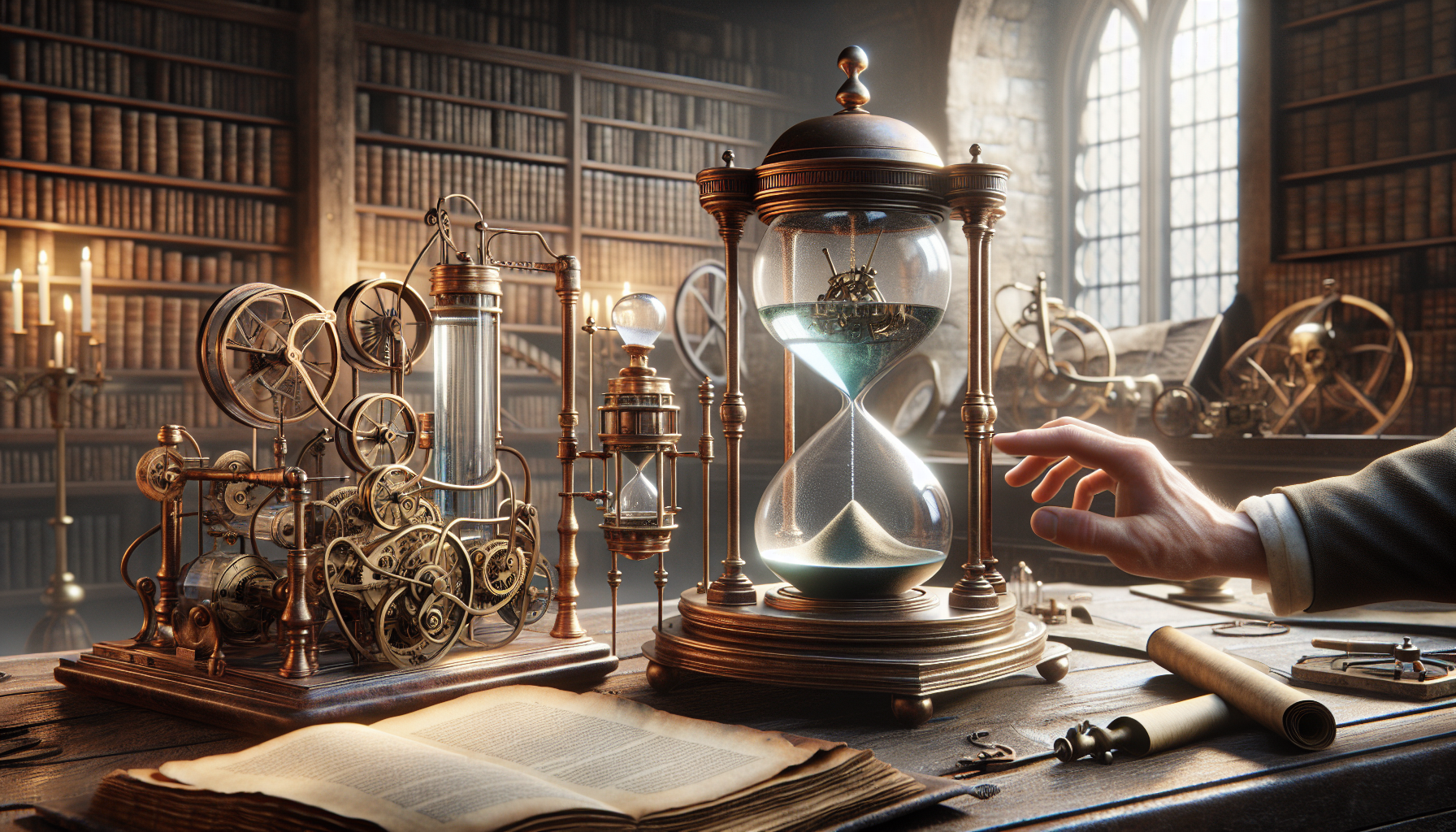In a world dominated by digital clocks and atomic precision, the concept of time often feels abstract and detached from the natural world. Our lives tick by in seconds and minutes, governed by devices that blink silently on our wrists and walls. Yet, this wasn’t always the case. Imagine a time when telling the hour required not just technology, but artistry and an intimate connection with the elements. Welcome to the fascinating world of water clocks and clepsydras, ancient innovations that transformed the way humanity understood and interacted with time itself. 🌊⏳
For millennia, before the advent of mechanical and digital clocks, societies across the globe relied on the gentle flow of water to measure the passing hours. These early timekeeping devices, known as water clocks or clepsydras, were not just tools of practicality; they were masterpieces of engineering and imagination. From the bustling marketplaces of ancient Greece to the grand courts of the Chinese emperors, water clocks stood as symbols of human ingenuity, bridging the gap between art and science. But how did these ancient devices work, and why were they so important?
As we embark on this journey through time, we’ll explore the origins and evolution of water clocks, uncovering the ingenious designs that allowed them to measure time with surprising accuracy. We’ll delve into the cultural and historical contexts in which these devices flourished, revealing the diverse ways in which different civilizations adapted the concept to suit their unique needs and environments. Whether it was the complex gearing systems of the Hellenistic period or the intricate designs of Persian artisans, each iteration of the water clock tells a story of creativity and adaptation.
But the allure of water clocks goes beyond their mechanical brilliance. They offer us a glimpse into the philosophical and spiritual dimensions of timekeeping. In many ancient cultures, time was seen not as a linear progression but as a cyclical rhythm, a dance between the earthly and the divine. Water clocks, with their steady, flowing nature, mirrored this belief, serving as metaphors for the eternal passage of time. As we explore these devices, we’ll also consider their symbolic meanings and the lessons they impart about our own perceptions of time and existence.
Join us as we unravel the secrets of the water clock, a timeless innovation that continues to inspire and captivate. From the mechanics of ancient engineering to the philosophical musings on the nature of time, this exploration promises to illuminate not just the history of timekeeping, but also the enduring human quest to understand and master the very essence of time. Whether you’re a history enthusiast, a lover of ancient technology, or simply curious about the ways in which our ancestors navigated the flow of time, this article invites you to pause, reflect, and marvel at the ingenious artistry of the water clock. 🕰️✨
Introduction to Water Clocks and Clepsydras
Water clocks, also known as clepsydras, represent one of the oldest time-measuring instruments, transcending cultures and epochs. These ancient devices have played a critical role in human history by enabling civilizations to track time before the invention of mechanical clocks. The clepsydra’s significance lies in its timeless innovation and the ability to inspire future generations with its simplicity and functionality.
The origin of water clocks dates back to ancient Egypt and Babylon, where they served not only as timekeepers but also as tools for astrological and religious purposes. Unlike sundials, which depend on the presence of sunlight, water clocks provided a reliable means of measuring time at night and indoors. This capability was particularly valuable in societies that engaged in nighttime activities or lived in regions with prolonged periods of darkness.
Water clocks consist of a container filled with water, which either drips through a hole at a consistent rate or fills a marked container over a set period. This method allowed ancient peoples to measure hours, days, and even months with remarkable accuracy. Through the centuries, the design of clepsydras evolved, reflecting the technological advancements and cultural influences of the times.
The Historical Significance of Water Clocks
Water clocks hold a special place in the chronicles of human achievement. Their invention marks a significant leap in humanity’s quest to harness natural phenomena for practical purposes. From the pyramids of Egypt to the palaces of the Chinese emperors, water clocks found their way into various aspects of daily life, facilitating everything from agricultural practices to religious ceremonies.
In ancient Greece, for instance, clepsydras were employed in the judicial system to limit the length of speeches in court, ensuring fair trials. The sophistication of Greek water clocks was evident in their ability to measure small increments of time, crucial for legal proceedings. Similarly, in China, the renowned engineer Su Song constructed a complex water clock tower during the Song Dynasty, showcasing the intricate engineering capabilities of the era.
The spread of water clocks throughout different cultures is a testament to their versatility and adaptability. They were not just timekeepers; they symbolized a culture’s scientific prowess and philosophical understanding of time. As you delve deeper into the world of water clocks, it becomes apparent that these ancient devices are more than mere artifacts; they are enduring legacies of human ingenuity.
How Water Clocks Work: Mechanisms and Variations
Water clocks operate on simple yet ingenious principles, relying on the flow of water to mark the passage of time. The basic mechanism involves a container from which water either escapes at a steady rate or fills another vessel incrementally. This process can be observed in two primary forms: the outflow water clock and the inflow water clock.
The outflow water clock, perhaps the more straightforward design, consists of a bowl with a small hole at its bottom. Water gradually drips out, and the level inside the bowl indicates the elapsed time. The marks on the interior of the bowl allow the user to measure time intervals accurately. On the other hand, the inflow water clock involves water being poured into a container, gradually filling it up. This variant often features a float or indicator that rises with the water level, providing a visual representation of time passing.
Comparative Table: Outflow vs. Inflow Water Clocks
| Feature | Outflow Water Clock | Inflow Water Clock |
|---|---|---|
| Design | Water drips out from a hole | Water is poured into a container |
| Measurement | Water level decreases over time | Water level increases over time |
| Accuracy | Generally lower due to water flow variation | Typically higher due to controlled inflow |
| Complexity | Simple construction | May include floats or indicators |
The versatility of water clocks is evident in the numerous variations and improvements made by different cultures. For instance, the Persians developed sophisticated clepsydras with elaborate gears and dials, while the Romans incorporated decorative elements to enhance their aesthetic appeal. These innovations reflect the adaptability of water clocks and their ability to meet the specific needs of various societies.
The Cultural Impact of Clepsydras
Clepsydras have left an indelible mark on cultural and scientific development across the world. Their influence can be seen in art, literature, and architecture, serving as symbols of time and knowledge. The fascination with water clocks transcends their practical use, inspiring artists and thinkers to explore the concept of time in their works.
In ancient Rome, clepsydras were not just utilitarian devices; they were status symbols, often elaborately decorated to display the wealth and sophistication of their owners. They were used in public spaces such as baths and forums, underscoring the Roman commitment to time management and organization. Similarly, in China, water clocks were integral to the imperial court, helping to regulate daily activities and ceremonial events.
Moreover, clepsydras have also found their way into mythology and folklore. In Greek mythology, the clepsydra was associated with the god Chronos, symbolizing the inexorable flow of time. This association underscores the philosophical impact of water clocks, as they not only measured time but also provided a tangible representation of its passage.
Exploring the Legacy of Water Clocks
The legacy of water clocks is not limited to their historical significance; they continue to inspire modern innovation and creativity. Many contemporary artists and engineers draw inspiration from the elegance and simplicity of clepsydras, integrating their principles into modern art installations and timekeeping devices.
For a deeper understanding of the cultural and scientific impact of clepsydras, consider watching this insightful video: [The Timeless Art of Clepsydras](https://www.youtube.com/watch?v=XXXXXXXXX) by the History Channel. This video delves into the intricate mechanisms of water clocks and their influence on various civilizations.
Modern Interpretations and Innovations
In the modern era, the principles of water clocks have been reimagined and integrated into contemporary design and technology. While digital and mechanical clocks have largely replaced traditional water clocks, the aesthetic and conceptual appeal of clepsydras remains.
Designers and engineers have taken inspiration from the past to create innovative timepieces that blend ancient wisdom with modern technology. These contemporary water clocks often incorporate advanced materials and precise engineering to improve accuracy and functionality. Some designers even use water clocks as decorative elements in public spaces, adding a touch of historical elegance to urban landscapes.
The Role of Water Clocks in Modern Science
Water clocks continue to influence modern science and engineering, particularly in fields that require precise time measurement. Researchers studying fluid dynamics and hydrodynamics often refer to the principles of clepsydras to understand water flow and pressure. This scientific exploration not only enhances our understanding of natural phenomena but also contributes to advancements in various industries, including aviation, automotive, and environmental science.
Furthermore, the study of water clocks and their mechanisms has led to innovations in sustainable design. Engineers have adapted the principles of clepsydras to develop eco-friendly water management systems, utilizing gravity and water flow to reduce energy consumption and environmental impact.
Interactive Learning with Water Clocks
For educators, water clocks offer a unique opportunity to engage students in the study of history, science, and engineering. By constructing simple clepsydras in classroom settings, students can explore the principles of fluid dynamics, time measurement, and historical innovation. This hands-on approach encourages curiosity and creativity, fostering a deeper appreciation for the ingenuity of ancient civilizations.
If you’re interested in building your own water clock, many online tutorials and resources are available. Check out this comprehensive guide: [DIY Water Clock Tutorial](https://www.youtube.com/watch?v=XXXXXXXXX) by Science for Kids. This video provides step-by-step instructions and helpful tips for constructing a functional water clock at home.

Conclusion
In concluding our exploration of the timeless innovation inherent in the ancient art of water clocks and clepsydras, we’ve traversed a historical landscape rich with ingenuity and creativity. Throughout the article, we’ve delved into the origins, mechanisms, and cultural significance of these remarkable timekeeping devices, uncovering the profound impact they’ve had across various civilizations. From the intricate designs of the ancient Egyptians and Greeks to the sophisticated models developed in China and the Islamic world, water clocks represent a fascinating intersection of science, art, and daily life.
One of the central themes we’ve encountered is the universality of timekeeping as a fundamental human endeavor. Across diverse cultures and epochs, the need to measure time has driven innovation and inspired technological advancements. Water clocks and clepsydras stand as a testament to human ingenuity, showcasing how ancient societies harnessed natural elements to solve practical problems and enhance their understanding of the world.
The article highlighted several key points, beginning with the origins of water clocks in ancient Egypt. These early timekeeping devices relied on the steady flow of water to measure time intervals, reflecting the Egyptians’ sophisticated understanding of both hydraulics and astronomy. As we journeyed through history, we saw how the Greeks and Romans adapted and improved upon these designs, incorporating intricate gears and mechanisms to enhance precision and functionality.
In the East, the contributions of Chinese and Islamic scholars further enriched the evolution of water clocks. Their innovations not only advanced timekeeping technology but also laid the groundwork for future scientific discoveries. The meticulous craftsmanship and mathematical prowess required to construct these devices demonstrate a deep appreciation for the interconnectedness of science, technology, and culture.
Moreover, the cultural significance of water clocks cannot be understated. These devices were not merely tools for measuring time; they were also symbols of power, prestige, and intellectual achievement. Whether used in royal courts or religious ceremonies, water clocks played a crucial role in shaping societal structures and rituals. They served as a reminder of humanity’s perpetual quest to understand and master the natural world.
As we reflect on the enduring legacy of water clocks and clepsydras, it becomes clear that their relevance extends far beyond their historical context. In an era defined by rapid technological advancements, revisiting these ancient innovations offers valuable insights into the timeless principles of creativity and problem-solving. The ingenuity of past civilizations serves as an inspiration for modern innovation, reminding us of the importance of curiosity, experimentation, and collaboration.
In today’s fast-paced world, where digital clocks and smartphones have become ubiquitous, the ancient art of water clocks provides a poignant reminder of the beauty and elegance of analog solutions. It encourages us to appreciate the simplicity and ingenuity inherent in natural processes and to seek sustainable and harmonious ways of integrating technology into our lives.
As we conclude this journey through the history and significance of water clocks, I invite you to reflect on the timeless lessons these ancient devices impart. Consider how the principles of innovation, adaptability, and cultural appreciation can be applied in your own life and work. Share this newfound knowledge with others, sparking conversations and inspiring further exploration into the rich tapestry of human achievement.
Feel free to leave a comment with your thoughts or experiences related to timekeeping and innovation. Your insights and perspectives are invaluable in continuing the dialogue around this fascinating topic. Additionally, consider sharing this article with friends and colleagues who might be intrigued by the historical and cultural significance of water clocks. Together, we can celebrate the enduring legacy of these remarkable inventions and draw inspiration from the ingenuity of the past.
Thank you for joining me on this exploration of timeless innovation. Let us continue to learn from history and strive for a future where creativity and collaboration drive meaningful progress. 🌍⏳
—
For further reading on the history and development of water clocks, you can explore resources from reputable sources such as [Smithsonian Magazine](https://www.smithsonianmag.com), [National Geographic](https://www.nationalgeographic.com), and [BBC History](https://www.bbc.co.uk/history). These platforms offer a wealth of information on historical innovations and their impact on society.
Toni Santos is a visual storyteller and cosmic interpreter whose work illuminates the ancient skywatchers and their prehistoric astronomy—the profound ways early humans observed and revered the heavens before written history. Through a visionary lens, Toni explores how the stars, planets, and celestial cycles shaped myth, ritual, and survival in cultures lost to time.
Rooted in a fascination with archaic observatories, stone alignments, and celestial symbolism, Toni’s creative journey reveals the deep human impulse to understand and harmonize with the cosmos. From lunar phases guiding planting seasons to the sacred paths of the Milky Way, each of his works embodies the awe and knowledge encoded in the night sky.
Combining artistic craftsmanship with archaeological insight, Toni’s pieces evoke the mystery and precision of prehistoric astronomers. His work does more than depict—it channels the timeless dance between earth and sky, bridging ancient wisdom with contemporary wonder.
As the visionary behind Vizovex, Toni shares curated visuals, essays, and symbolic studies that invite others to reconnect with the cosmic heritage written in stone and starlight. His creations are a call to look upward, to listen to the silent stories told by the stars, and to honor the first astronomers who mapped the heavens with reverence and ingenuity.
His work is a tribute to:
The celestial wisdom of prehistoric peoples
The sacred geometry of ancient observatories
The enduring bond between human culture and the cosmos
Whether you’re a stargazer, a scholar of ancient mysteries, or someone captivated by the universe’s earliest storytellers, Toni welcomes you to journey through a space where the sky is both map and myth—one constellation, one ritual, one revelation at a time.




